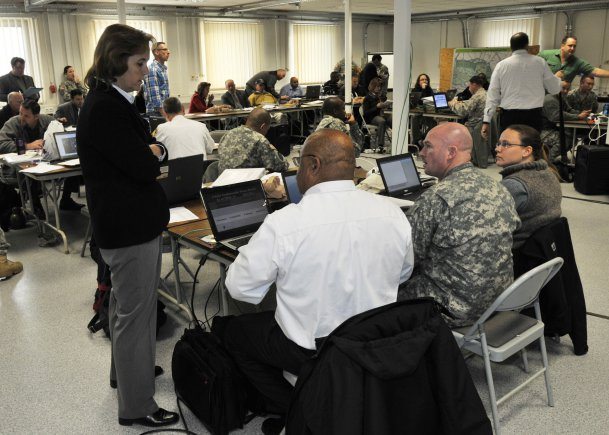In December, the United States Army Garrison Grafenwoehr teamed-up with the Joint Multinational Training Command’s Simulation Center to host the garrison’s annual force protection exercise.
However, the exercise took place without closing down roads, facilities or causing any inconvenience to the Grafenwoehr community. The annual training requirement was met using a virtual reality.
The JMTC’s Simulation Center spent several months modeling the garrison to work within Army gaming software known as Virtual Battlespace 2, said Ed Rykard, the JMTC’s Tactical Gaming manager. The simulation designers ensured the virtual community replicated the actual environment and what emergency responders would see on-scene, he said.
The all-day event took place in two adjacent buildings on the Grafenwoehr Training Area’s Camp Aachen. Emergency responders negotiated tasks in a 3-D replica of the Grafenwoehr military community, including roads, gates, schools and the Netzaberg housing complex, while garrison leaders were able to collect information and make decisions next door in an emergency command post.
Rykard said, the exercise planners developed a complex scenario involving a shooting and hostage situation at the garrison’s Netzaberg Elementary School. Military Police, garrison firefighters, and a Quick-Reaction Force from the 172nd Separate Infantry Brigade reacted to the incident, cordoned off the area and engaged the suspects inside of the school, using a keyboard, mouse and computer monitor located more than a mile from the actual school.
Peering into his computer monitor, Sgt. Louis Sandoval, a military policeman in Grafenwoehr, entered the virtual-exercise world with fellow first responders, Sgt. Robert Jackson and Police Capt. Mike Kreis.
Sandoval began the training and entered the school. After navigating through the school’s lobby and gym, and climbing stairs in a nearby stairwell, he engaged a lone-gunman. Sandoval wounded the opposing shooter, cuffed, and dragged him to a secure area where a second set of responders had already established a safe perimeter.
“These guys were very much into working together — so they were particularly effective,” said Mark Lahane, a JMTC Simulation Center facilitator. “We knew we would have to prepare something particularly “nasty” for them when they moved out again.”
Planners added more complexity than in the past, said Steve Hood, chief of training and operations at Grafenwoehr’s Directorate of Plans, Training, Mobilization and Security. For example, the garrison staff was graded on their ability to communicate during the crisis, he said.
Observer/Contollers at the Simulation Center “injected” rumors and unsubstantiated facts throughout the day through bogus Facebook and Twitter profiles from anxious community individuals. The garrison leadership had to address the information, or correct the erroneous information, said Hood.
Because the exercise was simulated in a virtual world, garrison leaders reacted and made decisions without the constraints of interrupting the normal weekday routine of the community, said Kim Alahmadi, USAG Grafenwoehr emergency manager.
“It’s as realistic as it can be without actually being on the ground,” she said. “That’s why I see command post exercises with the [Simulation Center] as the future of garrison force-protection training.”
Rykard said, the simulation training also provides cost-savings versus the traditional, boots-on-the-ground force-protection exercises.
“This force-protection exercise will probably run eight hours. In that eight-hour period, we’re not going to burn a drop of gas, we’re not going to put any wear and tear on vehicles,” he said. “But at the same time we should be able to meet all (the garrison’s) training objectives.”
Hood said, the training solidifies good working relationships between the many agencies and services needed during an emergency.










